MONICA HUERTA
critic • curator • creatrix
Essays

AN OPEN LETTER TO STUDENTS: Universities Do Not Deserve You
co-authored with Dan-el Padilla Peralta, The Nation, September 2025Excerpt: If we were together in a classroom, we would ask you: What does it mean that “the practical” that has been presented to you as a foregone conclusion is ultimately to the detriment of the planet’s well-being?
CONTINUE READING
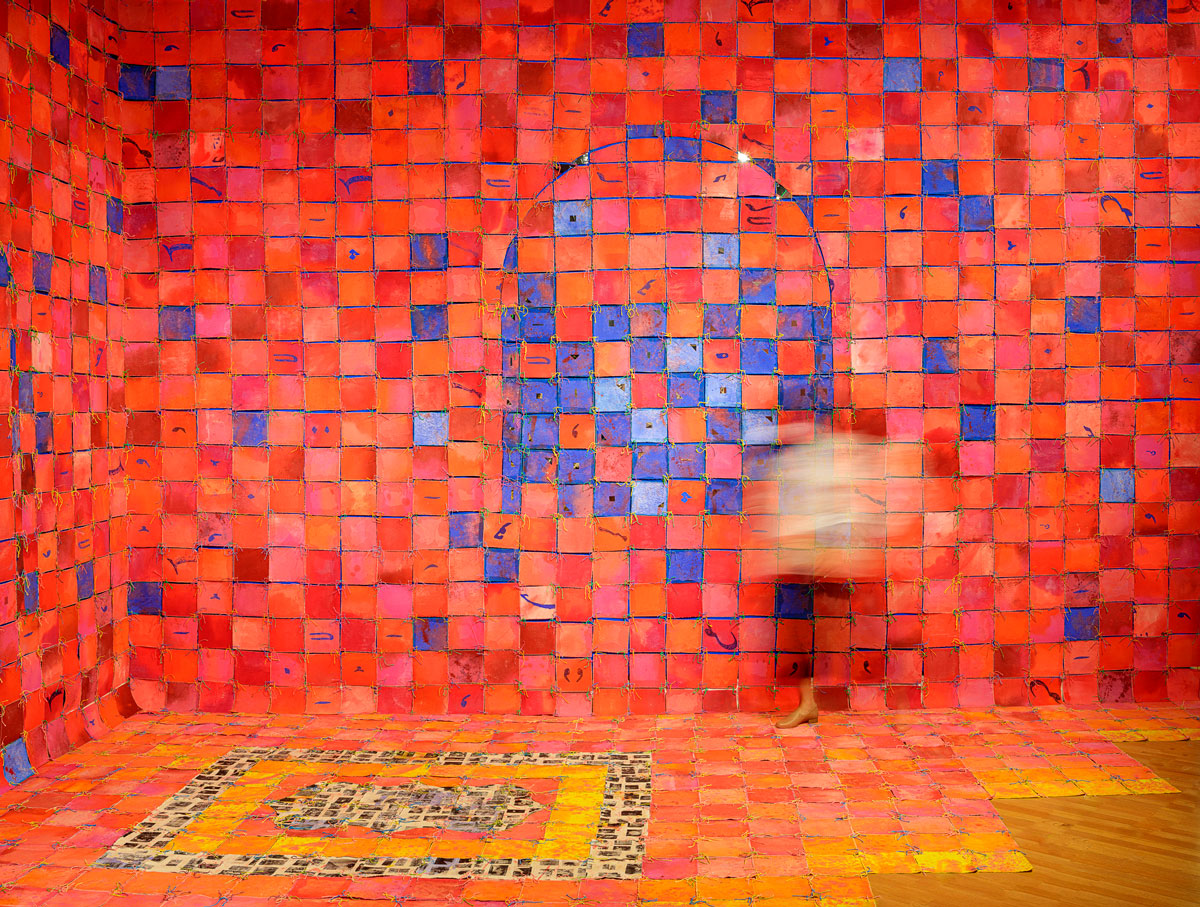
GLITCH|STICH: Sensing Survival in Ziba Rajabi’s Glitched Home
co-authored with Ava Shirazi, forthcoming, Society + SpaceExcerpt: Rajabi’s refusal to stretch the canvas—first an aspiration of return, then a critique of the traditions and institutions that would misread her—lends density to the compact rectangular shapes she cuts....She first paints the industrial thread that then stitches together a new semi-virtual, semi-concrete space; virtual in that it evokes screens that remain unseen in the work, and virtual in that this space “glitches,” too. The spaces between what she calls canvas-pixels give the impression that at any moment the whole might be rearranged, that the pixels might be capable of reconfiguring the image. Portable. This is a sense of glitch as temporary, as potential, even temporary potential energy, undivided from a glitch as the precarity of being held together with knots and stitches.
Image: Ziba Rajabi, Glitched Home 2021. Photo courtesy of artist.
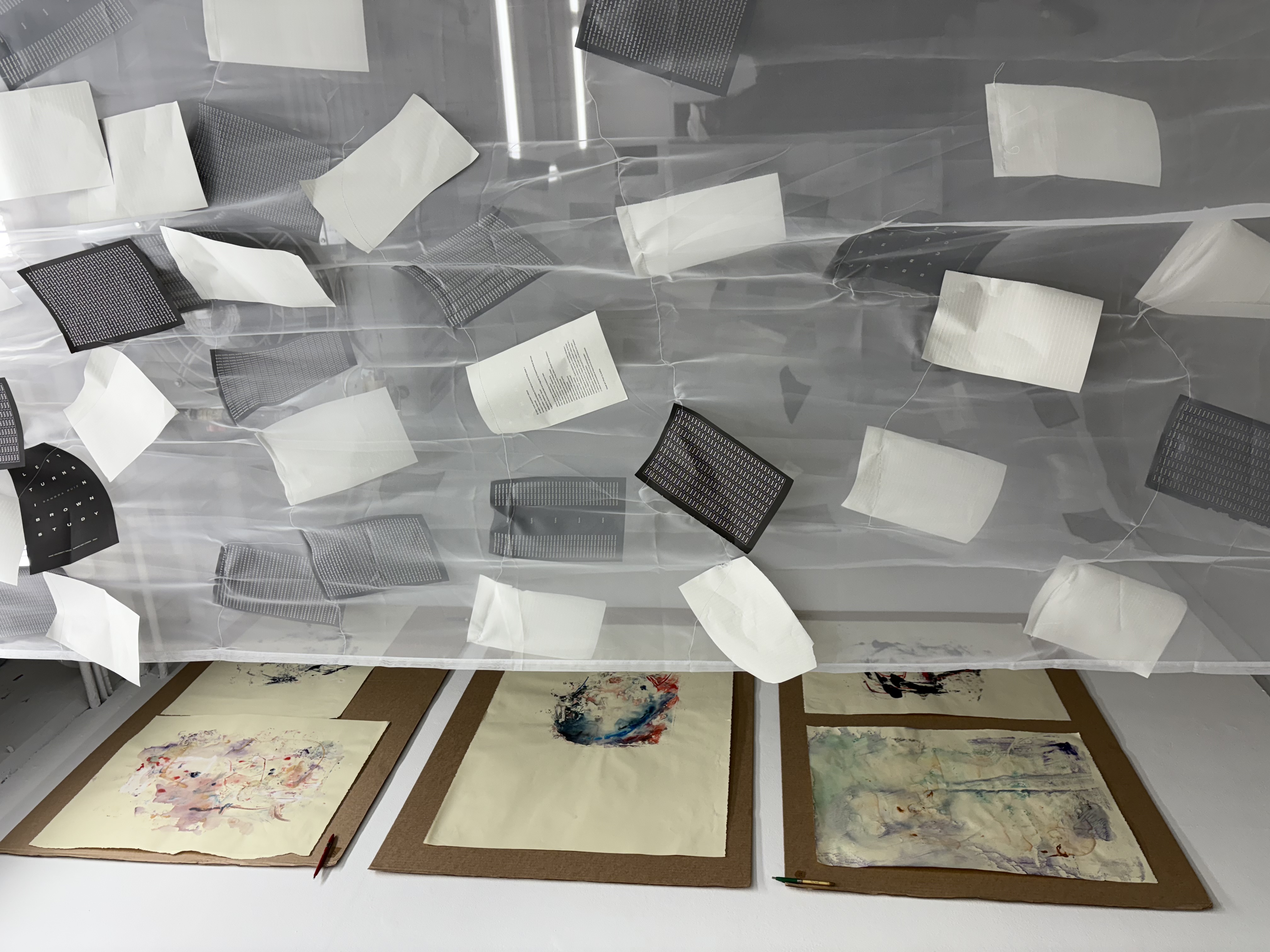
Where Brown Study Turns; on Sandra Ruiz’s Left Turns in Brown Study
ASAP/J, June 2025Excerpt: When else has soap been used to make a shrine? That is the wrong question: the ordinary—“an event and a sensation,” “both animated and inhabitable” (Kathleen Stewart, Ordinary Affects, 4)—is teeming with homes and their smells-sounds-threads-heartbeats. The sensory does not only lead to a memory, it compounds, expands, intensifies, dimensionalizes a memory, transgresses particularity (without erasing it) for a moment of mutual recognition.
CONTINUE READING
Image: Entrance hallway, "Sensory Turns and Visceral Riffs: From Syllable to Sound to Print," with monoprints by Daniel Hughes Vernola, inspired by Sandra Ruiz, Left Turns in Brown Study (Duke UP, 2024), Ortega y Gasset Projects, Brooklyn, New York, December 18, 2024. Photograph by M. Huerta.

Starting Without a Beginning: Tarrah Krajnak
Intervenxions, April 2025Excerpt: [Krajnak] seeks out the questions...historical ideas of “the female pose” raise. Sparse staging and white clothing emphasize the positioning of her limbs, her disinterest in articulating an intelligible expression, to take away everything but the pose, and even then, to be uninterested in the precision of its reproduction. The photographed poses might be inviting us to seek out the unimagined branching paths that lead somewhere else in time.
CONTINUE READING
Image: Tarrah Krajnak, REPOSE/Portfolio 16, 8x10 Silver Gelatin Print, 2022 to Present.

From Nothing to Letting Nothing Go
New Literary History, Vol. 55, No. 3-4 (2025)Abstract: This essay reengages Barbara Johnson's restaging of W. H. Auden's proposition that writing makes nothing happen. It pivots away from that proposition by moving with Latinx artist Sofía Córdova’s work toward the implicit and explicit commitments of contemporary networks of study that inherit intellectual genealogies of critique that would not recognize the “nothing” Auden and Johnson claim.
Image: Sofía Córdova, GUILLOTINÆ WannaCry, Yellow: Break Room (still), 2019-21. Three-channel video, color, sound, 25 min; published in JoanLosAngeles.org.

Photography
Elgar Concise Encyclopedia of Law and Literature, edited by Robert Spoo and Simon Stern (2025)Abstract: This entry follows conflicts over privacy and evidence among photography, law, and literature’s historical interrelations. It offers how various literary authors found in photography’s legal conundrums a way to grapple with modernity’s vocabularies for its own contradictions; these challenges for law were intertwined with the aesthetic questions photography prompted of art more generally. This entry also points to important theorists whose writings help illuminate literary engagements with the ‘laws of image,’ as Samantha Barbas has phrased it.
ORDER HERE
Image: Attributed to William Mumler, or possibly Helen F. Stuart; Five ‘spirits in background, 1861-68, Getty Digital Collection.

Realism’s Reputations, Financialized Whiteness
American Literature, Vol. 96, No. 3 (2024)Abstract: This essay uses the legal rearticulation of reputation as white heteropatriarchal property in the United States to piece apart the preoccupation with characters’ reputations in realist fiction. It focuses on two later-nineteenth-century arenas of what property theorist and legal scholar K-Sue Park has called the “generative dynamics” of racial capitalism: new markets in private commercial credit and the socio-legal (re)production of reputation. In so doing, the essay unearths realism’s invisiblized generic presupposition that reputations are a neutral or self-evident category of experience.
CONTINUE READING
Image: A. B. Wenzell illustration for Edith Wharton, House of Mirth (1905)
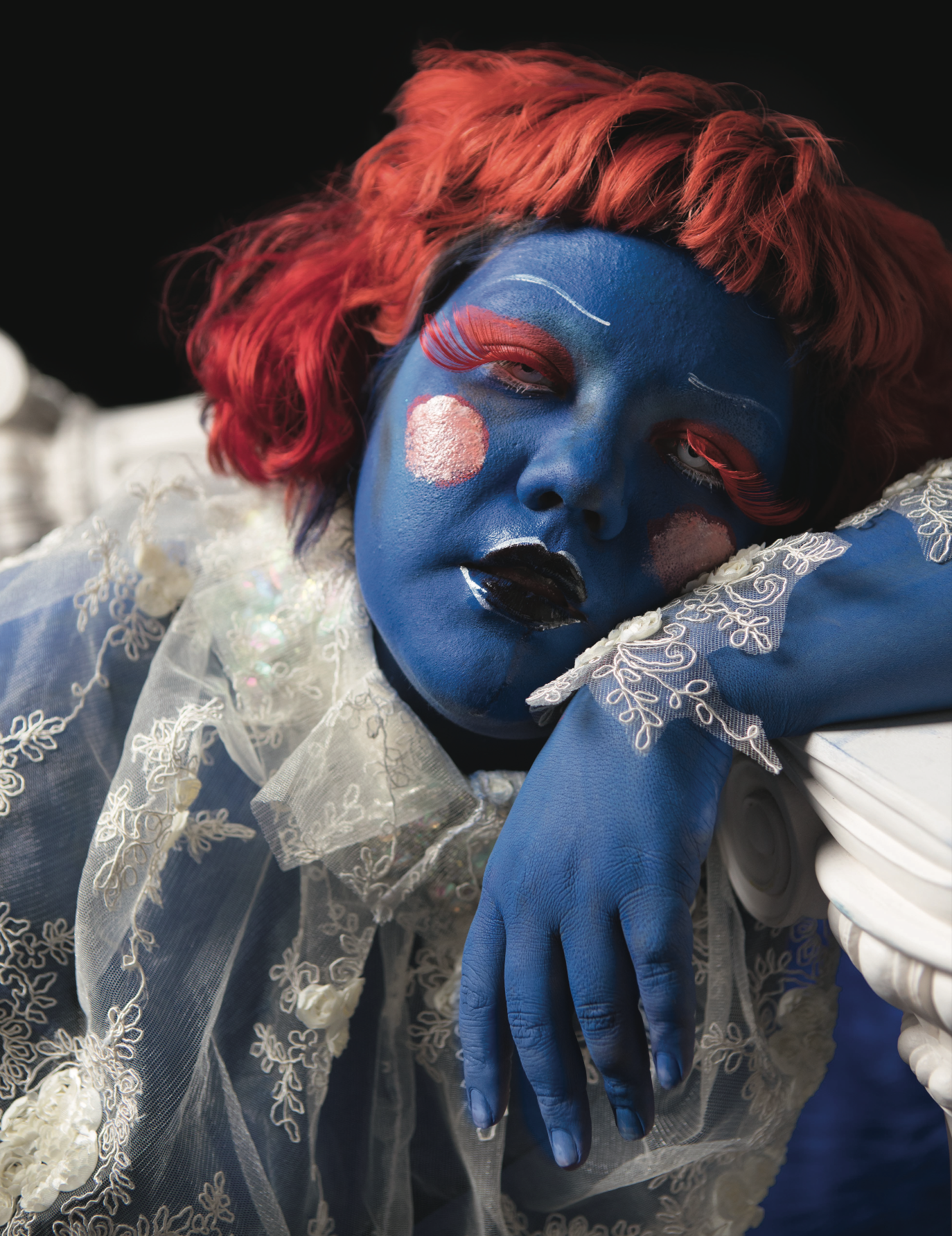
On Rearrangement: “You Belong Here: People, Place, and Purpose in Latinx Photography”
ArtForum, November 2023Excerpt: THE WORDS CAST arms open and outstretched, signaling recognition and an offer that does not presume the addressee is a hugger: You belong here. Heard in a slightly different register, it’s an insistence in addition to an affirmation, as though someone else has said otherwise—a someone the words don’t need to mention, a someone the speaker and “you” together do not allow to set the terms. Or, there might not be a reason to say the words except in the way an ocean greets sand, one beloved to another beloved living in its meaning. In any case, and though received differently depending on where and how you stand in the world, in the gallery we’re overhearing a conversation whose coordinates might be in the middle of being rearranged.
CONTINUE READING
Image: Gabriela Ruiz and Bibs Moreno, Untitled, 2017, ink-jet print, 30 × 20"
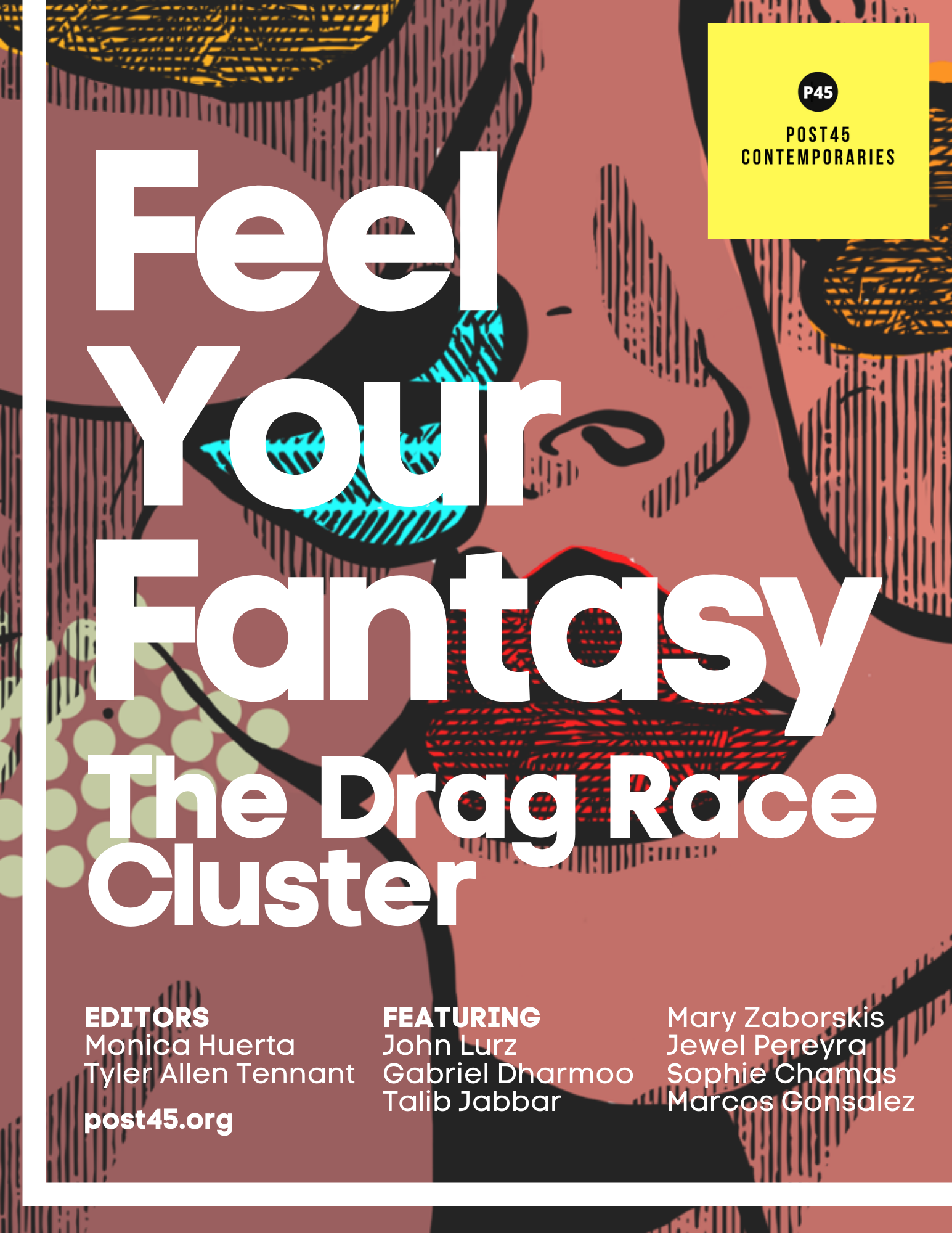
Co-editor || Feel Your Fantasy: The Drag Race Cluster
Contemporaries: a post45 digital space, co-edited by Monica Huerta and Tyler Allen Tennant, December 2022Table of Contents || Reading Challenges: Introduction - Tyler Allen Tennant || Can I Get an Amen? or Citation and the Speech of Fantasy - John Lurz || Bijuriya Chamke! Curating My Drag Sound - Gabriel Dharmoo || Drag Queens in Stars and Stripes - Talib Jabbar || Queer Childhoods and Drag Race - Mary Zaborskis || “I Love You Dearly, Bitch” - Jewel Pereya || Drag Queens Everywhere - Sophie Chamas || Piñata Drag: Crystal Methyd and the Pleasures of Quirky Latinx Aesthetics - Marcos Gonsalez ||
|| Drag is the Medium [Outro] - Monica Huerta and Brittany Lynn (Ian Morrison)
CONTINUE READING

Drag is the Medium [Outro]
Feel Your Fantasy: The Drag Race cluster of Contemporaries: a post45 digital space, co-edited by Monica Huerta and Tyler Tennant, December 2022Abstract: In this lightly edited interview, Ian Morrison — who performs as Brittany Lynn, and is the Don of Philly's Drag Mafia — says his priority is for folks at his shows to have a good time. His steady, open demeanor (and glowing skin! tell me your secrets!) makes his unmistakably South Philly cadence that much more charming. He describes Brittany as "a mom from South Philly," peppering performances and social media posts with "Hey, hun," and our conversation with "do you know what I mean(s)?" that sound a little more like "jknowwhaddImean?"
CONTINUE READING
Image: Brittany Lynn (Ian Morrison). Photo courtesy of Morrison.

An Essay Written in Sand
ArtForum, December 2021Excerpt: What I didn’t know was how to feel in touch with the year-plus between us, in the fleshy, nervy, felt ways of forty years of habit. Those habits are where materiality and immateriality, narrative, history, psychology, and physiology have usually danced a tango. Even if some years it’s been a tango on sand, it’s choreography my consciousness and sensorium together have known and kept for me.
CONTINUE READING
Image: Grids of hay stabilize against desertification, Minqin, China. Photo: Michael Reynolds/EPA/Shutterstock

Hold Still: Coming Undone Reading Print Culture Like a Work of Art
New Directions in Print Culture Studies: Archives, Materiality, and Modern American Culture, eds. Jesse Schwartz and Daniel Worden, Bloomsbury (2022)Excerpt: My reason for trying to “think like a work of art,” is to find still another way of relating to historical and aesthetic worlds that are ultimately irretrievable. Like [Stephen] Best, I am not trying to recover them in order to suture the genocidal politics of the nineteenth century with oppositional politics of the twenty-first. ... What I try to reencounter in these images are the linked and unstable channels of geography and time.
CONTINUE READING
Image: Renowden, Redeemed in Virginia by Catherine S. Lawrence. Baptized in Brooklyn….by Henry Ward Beecher, May, 1863. Fannie Virginia Casseopia Lawrence, a Redeemed Slave Child, 5 years of age. Schomburg Center for Research in Black Culture, Photographs and Print Division.
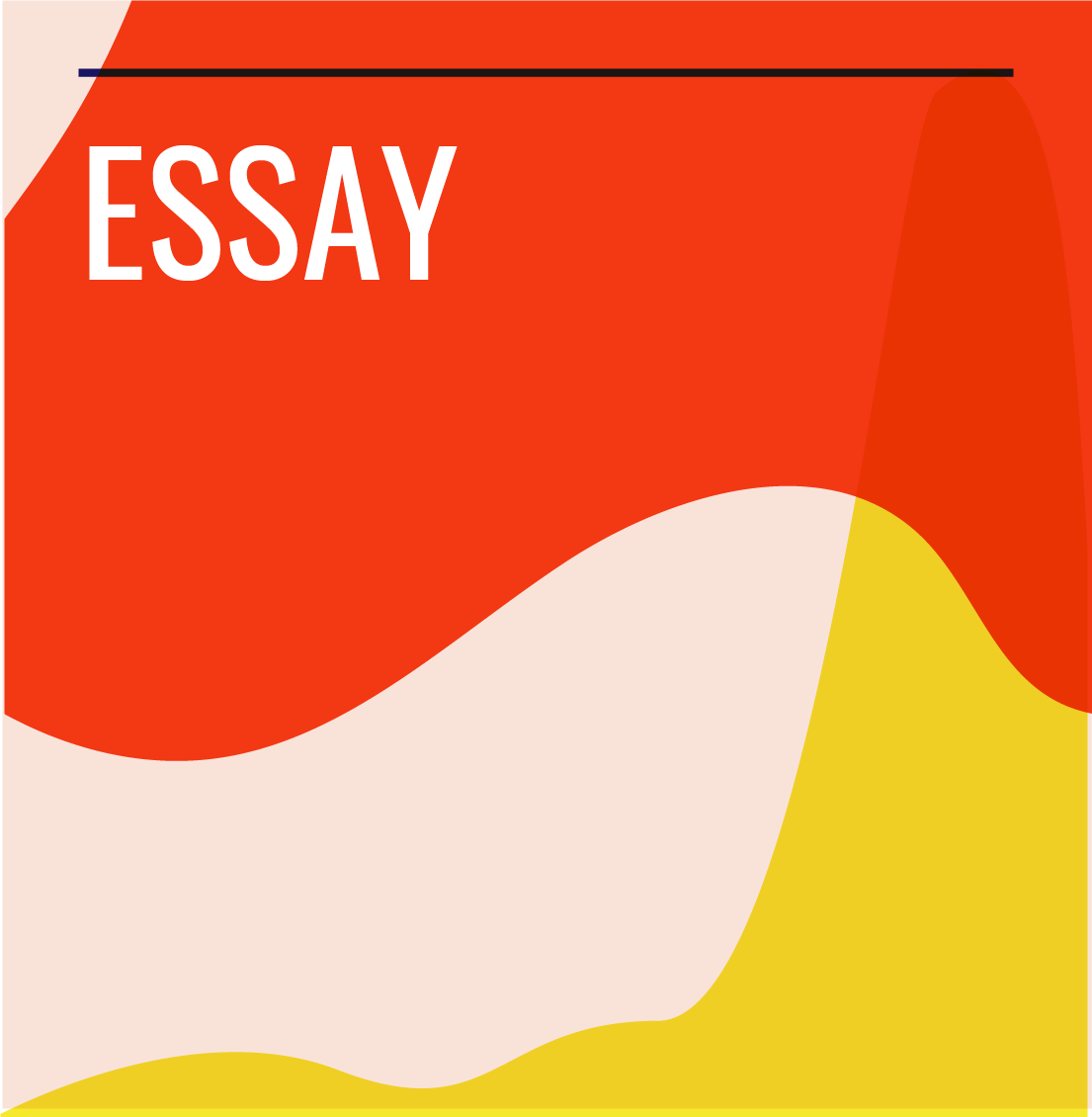
Find Something New to Love (as long as it’s not Taco Bell’s Mexican Pizza)
Los Angeles Review of Books, December 2020Excerpt: Cheese is the penultimate layer of the Mexican Pizza, before the black olive slices, diced tomatoes, and sliced green onion, but after enchilada sauce, all of which is layered on top of two fried tortillas (née tostadas) that hug close to either seasoned ground beef and refried pinto beans or just the beans. Like some of the most comforting things, it’s really a very simple idea.
CONTINUE READING
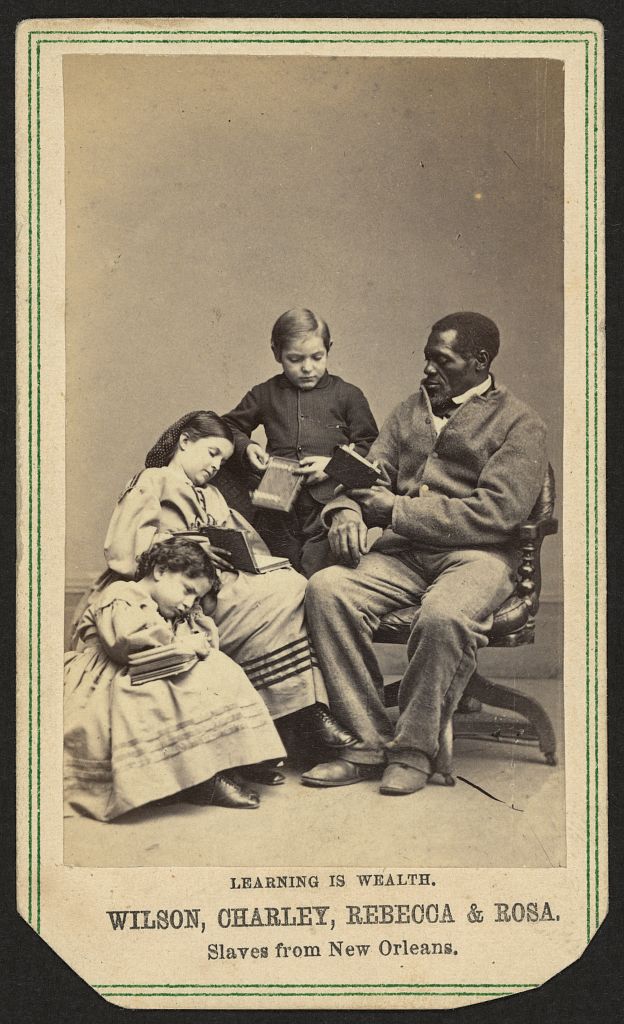
Anti-Racism and the Problem of the Soul
Los Angeles Review of Books, June 2020Excerpt: So very many of the performances of “reckoning” or “recognizing” happening in private and public manage to feel hollow even when urgently expressed.
CONTINUE READING
Image: Charles Paxon,Learning is Wealth. Wilson, Charley, Rebecca & Rosa. Slaves from New Orleans, 1864.

Expanding the Sayable: Listening, Teaching
#TeachingC19, eds. Sari Edelstein, Don James McLaughlin, and Kelly Ross (2019)Excerpt: I’ll be honest: the conversation with my class about classroom culture did not begin comfortably. ... There was no immediate, grand epiphany, and the group did not instantly dive in or feel inspired to take a risk. It was, instead, a little awkward.
CONTINUE READING

Geometry & Mechanism: Material Metaphors and the Force of Uncertainty of Legal Thought
New Literary Analysis of Law Special Issue of Critical Analysis of Law (2018)Abstract: This essay takes up the metaphors through which realists and Critical Legal Studies scholars created an idea of legal formalism. These insistently material metaphors emphasized that the errors of so-called formalist jurisprudence arose from two things: first, the material location of law; and second, the purpose of law in relation to the material world. The essay shows how metaphor in particular was rhetorically suited to this kind of dual work. This essay shows that legal realists’ reorientation toward the material was forged through making material forces precisely out of the immaterial of contingency and uncertainty.
CONTINUE READING

The Queer Digital Touch of Racial Sight
Queer Circuits in Archival Time Special Issue of Women & Performance: A Journal of Feminist Theory, Vol. 24, no. 2 (2018)Abstract: Michael Jason Enriquez digitally altered celebrity headshots to make the celebrites look like they are wearing chola make-up. The “cholafied” headshot circultated on a Tumblr account, which at its most popular, in 2012 and 2013, spread to over 160 countried and had half a million page views, over 20,000 Tumblr followers, 90,000 reblogs, and at least 60,000 shares on Facebook. Attending to the sensory, affective, and historical rituals hidden in the haptic register of this quotidian digital archive...insinuates and approximates one aspect of what racial seeing feels like in our contemporary moment.
CONTINUE READING
Image: Michael Jason Enriquez, homegirl used all my aquanet, from Cholafied.

What’s Mine: Involuntary Expressions, Modern Personality, and the Right to Privacy
J19: The Journal for Nineteenth Century Americanists, Vol. 4 No. 2 (2016)READ HERE
Image: Newsboy cabinet card, Marion Manola, date unknown, Billy Rose Theater Collection, New York Public Library.

Review of Jennifer De Leon’s White Space: Essays on Culture, Race, & Writing (2021)
American Literary History, Vol. 36, No. 1 (2024)Excerpt: I put the sentences here, sometimes, to be free from carrying them with me. This is when writing becomes an archive. I let the sentences happen to me, sometimes, because what I need is for direction to reveal itself. This is when writing activates thinking. I carve sentences into buildings, into cities, to hold a world that would not exist without them. This is how writing pushes back against gentrifying buildings, unlivable cities, and sinking shorelines. I also keep some sentences quiet, afraid more won’t arrive. But writing isn’t always safe, even when we clutch at its fictions.